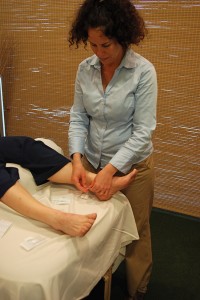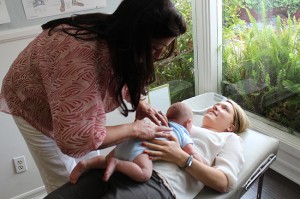To Dr. Gila Peled, helping a woman have a baby is one of the most joyous aspects of her career. Peled, who received her doctorate in Reproductive Chinese Medicine and is certified in labor and delivery treatments, said, “Being there for a woman from start to finish in her pregnancy journey is such a blessing.” Peled owns Island Acupuncture and Fertility Center, where she specializes in acupuncture treatments from helping women conceive and alleviating pregnancy ailments and preparing women’s bodies for labor and delivery. “It’s such a profoundly important time in a woman’s life,” she said, “and I’m so happy when I get to be a part of it.” She is one of many professionals on the island who is dedicated to — and passionate about — providing a holistic approach to pregnancy and birth.
When it comes to pregnancy and childbirth today, America ranks poorly in protecting mothers and infants from childbirth-related deaths (the Japanese infant mortality rate, for example, is 60 percent lower than in the United States). Furthermore, the rate of maternal deaths has risen over the past 10 years, the number of premature babies is higher now than it was in the 1980s and 1990s, and the cesarean section rate is at 33 percent (the World Health Organization recommends the optimal rate to be between
5 and 10 percent, which it was in 1965). Still, a number of technological advancements have been made in obstetrics that can be life saving when they are medically necessary.
Many experts, however, feel that these interventions, including the use of artificial hormones to induce labor, epidurals, and the use of fetal extraction tools have begun to interfere with the natural, healthy process of labor and birth.
A healthy, full-term pregnancy can range anywhere from 39 to 42 weeks, but recent years have seen an increase in elective C-sections and women being encouraged to artificially induce labor by the 40-week mark. (Inducing labor is a procedure that uses artificial hormones such as Pitocin to start and/or intensify labor contractions. Most hospital policies require that a woman have the baby within 24 hours of the start of induction — often leading to a C-section or the use of forceps or vacuum when a woman isn’t considered to be progressing fast enough in her labor). Epidurals, which are commonly used for pain management during delivery, can also slow labor.
“A big part of avoiding unnecessary medical interventions and having a smoother labor is caring for and preparing your body before delivery,” said Dr. Kerry Keiser of Discover Wellness Coronado. Here are some ways expectant moms (and moms expecting to be expecting) can experience more comfortable pregnancies and healthier births.
Chiropractic care
The benefits of chiropractic care during pregnancy are manifold. “Not only do adjustments reposition the spine, ribs, and pelvis to minimize discomfort due to the baby’s positioning and the downward pressure exerted as he grows, that repositioning allows optimum room for baby to grow and position himself properly,” said Dr. Deborah Marin of Discover Wellness Coronado. Hormonal changes during pregnancy combined with the baby’s weight can throw a woman’s pelvis out of line, possibly keeping the baby from settling into the proper birth positioning. Improper positioning in the uterus (called breech) can often lead to a medically required C-section when it’s time to deliver. If a baby has turned breech, chiropractic adjustments — particularly a method called the Webster Method — have been shown to be effective in helping the baby shift into the proper position.
Another major benefit, said Marin, is that “having strong and balanced muscles along with properly mobile joints prepares a woman’s body for the burden of child bearing.”
“Restoring optimal function of the nervous system through chiropractic adjustments can especially aid with labor itself, leading to smoother dilation, efficient effacing, and even a reduced need for analgesics,” she said. “When the spine is aligned properly, the baby is able to put pressure on the cervix effectively, reducing labor time.” A well-documented study also showed that regular chiropractic care during pregnancy resulted in a 24 percent decrease in labor time for first-time mothers and a 39 percent decrease for experienced moms. And, said Marin, “The benefits of chiropractic care don’t stop after delivery. Proper alignment is vital to postpartum health because an optimally functioning nervous system ensures balanced hormone production, reducing the likelihood of common post-delivery issues such as depression and insufficient milk production.”
Marin emphasized the importance of chiropractic adjustments after delivery — for both mother and baby. “The demands of new motherhood — like breastfeeding and carrying your baby — can be hard on the body. Doctors of chiropractic can help with ergonomic positioning, alleviating the physical stresses of those new challenges.”
Chiropractic care can benefit the newborn as well, Keiser explained. “Everything from a vaginal birth to a C-section to the use of vacuuming and forceps for delivery can cause trauma to the child’s spine. Chiropractic adjustments restore proper spinal alignment, which in turn ensures optimal functioning of the nervous system for the developing spine. And when the nervous system is functioning the way it should, newborns have a lower incidence of ailments like colic, earaches, constipation or diarrhea and problems with proper nursing.”
Acupuncture treatments
Acupuncture is a traditional Chinese therapy that’s thousands of years old — and now has much research supporting its efficacy. While modern Western medicine still has not collaboratively defined exactly how acupuncture works, Peled explained, “It is generally believed that activating certain pressure points can regulate the body’s nervous system, boosting endorphins, regulating blood flow, and perhaps altering the way the body responds to certain sensations.” Peled noted that acupuncture is effective for relieving many of the discomforts of pregnancy such as indigestion, insomnia, high blood pressure and fatigue. And, she said, “Many studies support that acupuncture can help turn a breech baby, effectively start labor, shorten labor times, and lower a woman’s need for analgesics during labor. Treatments can even prevent miscarriage and aid in post-natal recovery.”
A study published in the Clinical Journal of Pain compared groups of laboring women and their need for pain medication. In the group who received acupuncture treatments, only 11 percent of women asked for pain medication, compared to 39 percent in the group that did not receive acupuncture. Furthermore, of 103 patients asked, 89 said they would do the acupuncture treatments again for subsequent labors. Another study published in the Journal of Maternal-Fetal and Neonatal Medicine found that women who used acupuncture treatments to encourage the onset of labor went into labor an average of 21 hours sooner than women who did not. And women who received acupuncture were less likely to have a C-section: 17 percent of the women who received acupuncture, compared to
39 percent of women who did not, had babies delivered by cesarean.
Doula support
A doula (derived from an ancient Greek word meaning “female slave”) is a labor coach whose job is to assist a woman physically and emotionally before, during and after her labor (and help a nervous soon-to-be-father keep his wits about him!). A doula meets with a pregnant woman in the months leading up to delivery to provide emotional support and help her plan for birth. During labor, doulas (who cannot intervene medically) assist with breathing and birthing techniques, emotional guidance, and physical support such as massage and facilitating labor positions. Doulas can also provide postpartum emotional support for new parents.
Care Messer, doula and owner of the San Diego Birth Education Center said, “Getting a doula has been proven to decrease medical interventions and lead to healthier postpartum parenting.” In fact, several studies have shown that support from a doula is beneficial for both the mother and the newborn, including shorter labors, fewer delivery complications and C-sections, fewer incidences of the use of fetal extraction tools (such as forceps and vacuums), improved newborn Apgar scores, reports of higher maternal satisfaction with birth experiences, lower rates of postpartum depression, and increased success with breastfeeding. Messer said, “Education gives you options for an amazing birth experience. A family embarking on the birthing and parenting experience should feel supported and have an idea of success – that’s why we’re here.”
Fun Stork Stats
$15k – average cost billed to insurance for a vaginal, hospital birth
1.4% – number of women who choose home birth
4 million – approximate number of babies born in America each year
Tuesday – most popular day of the week to give birth
September – most popular month to give birth
25 – average age of moms having their first baby
8% – number of births attended by midwives
Jacob & Sophia – most popular boy and girl names for 2014



